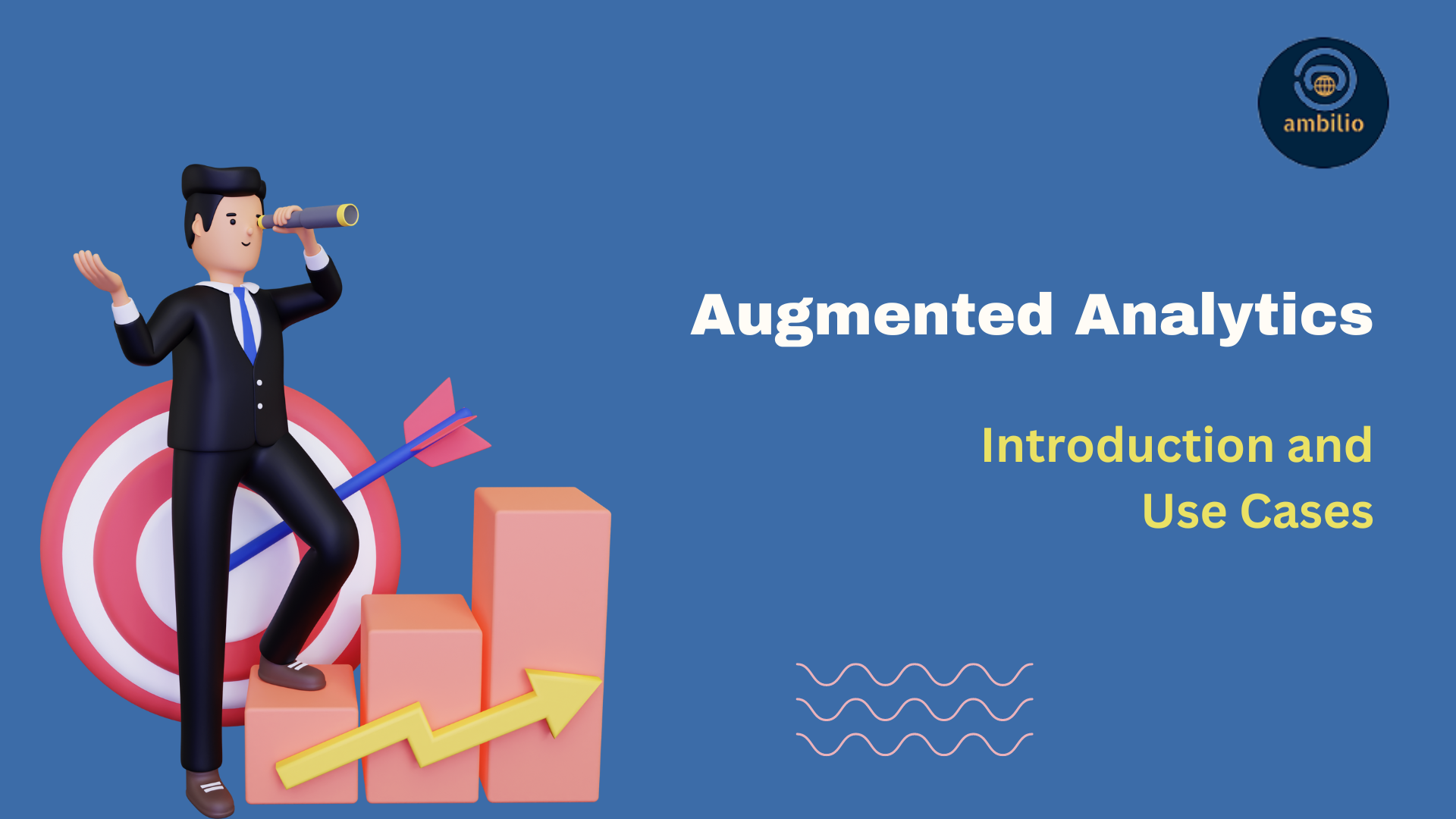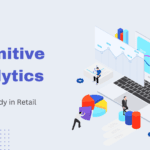Augmented analytics is used to enhance the data analysis process and provide deeper insights into data sets. Its most important benefit is that it leverages advanced technologies, such as machine learning and natural language processing, to automate the process of data analysis, which can lead to faster and more accurate insights. By automating much of the data analysis process, augmented analytics enables data scientists and business analysts to focus on interpreting the results and making informed decisions, rather than spending time manually preparing and analyzing data. This can result in faster, more accurate decision-making, which can ultimately drive business success. Here we present a detailed report on augmented analytics, its benefits and some industry use cases.
What is Augmented Analytics?
Augmented analytics is an approach to data analysis that leverages advanced technologies, such as machine learning, natural language processing, and artificial intelligence, to automate much of the data preparation and analysis process. By using these technologies to automate the analysis of large and complex data sets, augmented analytics can help data scientists and business analysts quickly identify important patterns, trends, and insights that might otherwise be missed. Additionally, augmented analytics often uses natural language processing to help users ask more intuitive questions and receive answers in a more user-friendly format, making it accessible to a wider range of users within an organization. Overall, augmented analytics aims to provide faster, more accurate insights into data, while also enabling more people within an organization to make data-driven decisions.
Example 1:
Let’s say a company wants to analyze customer feedback data to identify common themes and sentiments. Traditionally, this would involve a data scientist or business analyst manually reviewing the feedback data, creating charts and graphs, and identifying patterns and insights. This process can be time-consuming and prone to errors or biases.
With augmented analytics, the process is automated and streamlined. First, the system would automatically ingest customer feedback data from multiple sources, such as social media, surveys, and customer support tickets. Next, the system would use natural language processing (NLP) to analyze the text of the feedback and identify common themes, such as product quality, customer service, and pricing. The system might also use sentiment analysis to determine whether the feedback is positive, negative, or neutral.
Using machine learning algorithms, the system can identify patterns and insights in the data that might be difficult to detect manually. For example, the system might identify that customers who mention “product quality” in their feedback are also more likely to mention “customer service” and “pricing.” This type of insight can help the company identify areas for improvement and prioritize its resources more effectively.
Finally, the system would present the insights to the user in a user-friendly format, such as a dashboard or report. The user can then explore the data further, ask follow-up questions, and use the insights to make data-driven decisions.
Overall, augmented analytics automates much of the data analysis process, enabling companies to gain faster, more accurate insights into their data and make more informed decisions.
Example 2:
Let’s say a retail company wants to analyze its sales data to identify which products are selling well and which are not. Traditionally, this would involve a data analyst manually reviewing the sales data, creating charts and graphs, and identifying patterns and insights. This process can be time-consuming and may miss important insights hidden within the data.
With augmented analytics, the process is automated and streamlined. First, the system would automatically ingest the sales data from multiple sources, such as point-of-sale systems, online sales platforms, and inventory management systems. The system would then use machine learning algorithms to identify which products are selling well and which are not, as well as any trends or patterns in the sales data.
The system might also use predictive analytics to forecast future sales trends and identify opportunities for growth. For example, the system might identify that a certain product category is likely to experience increased demand in the near future, based on past sales trends and external factors such as seasonal trends or economic indicators.
Finally, the system would present the insights to the user in a user-friendly format, such as a dashboard or report. The user can then explore the data further, ask follow-up questions, and use the insights to make data-driven decisions about product inventory, marketing strategies, and more.
Overall, augmented analytics can help retailers gain a better understanding of their sales data, identify opportunities for growth, and make more informed decisions about their business strategy.
Major Benefits of Augmented Analytics
There are several major benefits of this analytics approach, including:
- Improved accuracy: By using advanced technologies like machine learning and natural language processing, augmented analytics can provide more accurate insights into data than traditional methods.
- Faster insights: Automation of much of the data analysis process can enable faster insights, allowing organizations to make decisions more quickly.
- Increased productivity: Augmented analytics can reduce the time and effort required for data preparation and analysis, enabling data scientists and business analysts to focus on more high-value tasks.
- Accessibility: With natural language processing and user-friendly interfaces, augmented analytics can make data analysis more accessible to a wider range of users within an organization.
- Deeper insights: By using advanced techniques such as predictive analytics, augmented analytics can uncover insights and patterns that might not be apparent through manual analysis.
- Scalability: Automated data analysis can be scaled up or down depending on the size of the data set, enabling organizations to analyze larger and more complex data sets more easily.
Overall, augmented analytics can help organizations gain deeper insights into their data, make more informed decisions, and ultimately drive business success.
Steps involved in Augmented Analytics
The steps involved in augmented analytics typically include:
- Data preparation: The first step in augmented analytics is to gather and prepare the data for analysis. This may involve collecting data from various sources, cleaning and formatting the data, and combining it into a single data set.
- Data analysis: Once the data is prepared, augmented analytics tools can automatically analyze the data using advanced techniques such as machine learning, natural language processing, and predictive analytics. This can help identify patterns, trends, and insights that might be difficult to detect manually.
- Data visualization: After the analysis is complete, the insights are presented in a user-friendly format such as charts, graphs, and dashboards. This allows users to easily explore the data and identify key takeaways.
- Natural language processing: Many augmented analytics tools also incorporate natural language processing, which enables users to ask questions in a more intuitive way and receive answers in a more user-friendly format.
- Human review: Although augmented analytics tools can automate much of the data analysis process, it’s still important for humans to review the insights and make decisions based on the data. This can involve identifying key takeaways, developing action plans, and sharing insights with stakeholders within the organization.
Overall, augmented analytics involves a combination of advanced technologies and human review to help organizations gain deeper insights into their data and make more informed decisions.
Augmented Analytics Use Case 1: Healthcare industry
Use case: Improving patient outcomes through augmented analytics
In the healthcare industry, augmented analytics can be used to improve patient outcomes by analyzing large and complex data sets, identifying patterns and trends, and providing insights that can inform clinical decision-making. Here’s an example of how augmented analytics might be used to improve patient outcomes for a specific condition, such as chronic obstructive pulmonary disease (COPD):
- Data collection and preparation: To analyze COPD patient outcomes, a healthcare organization might collect data from multiple sources, including electronic health records, patient surveys, and clinical trial data. The data would then be prepared by cleaning, formatting, and combining it into a single data set.
- Data analysis: Next, an augmented analytics tool would be used to analyze the data set, using advanced techniques such as machine learning and predictive analytics. The tool would identify patterns and trends in the data, such as which treatments are most effective for different types of COPD patients, which patients are at the highest risk for complications, and which factors contribute to better or worse outcomes.
- Data visualization: The insights gained from the data analysis would be presented in a user-friendly format, such as dashboards and reports. This would allow clinicians to easily explore the data and identify key takeaways that can inform clinical decision-making.
- Natural language processing: Many augmented analytics tools also incorporate natural language processing, which enables clinicians to ask questions in a more intuitive way and receive answers in a more user-friendly format. For example, a clinician might ask, “What treatments are most effective for COPD patients with a history of smoking?” and receive a list of recommended treatments based on the data analysis.
- Clinical decision-making: Armed with the insights gained from the augmented analytics tool, clinicians can make more informed decisions about patient care. For example, they might use the data to develop personalized treatment plans based on a patient’s individual characteristics and risk factors or to identify patients who are at high risk for hospital readmission and provide additional support to prevent readmissions.
Overall, augmented analytics can help healthcare organizations gain deeper insights into patient outcomes, identify opportunities to improve care, and make more informed decisions that can ultimately lead to better patient outcomes.
Augmented Analytics Use Case 2: Media and entertainment industry
Use case: Personalizing content recommendations through augmented analytics
In the media and entertainment industry, augmented analytics can be used to personalize content recommendations by analyzing large and complex data sets, identifying patterns and trends in user behavior, and providing insights that can inform content recommendations. Here’s an example of how augmented analytics might be used to improve content recommendations for a specific media streaming platform:
- Data collection and preparation: To personalize content recommendations, a media streaming platform might collect data from various sources, including user viewing history, search queries, and social media activity. The data would then be prepared by cleaning, formatting, and combining it into a single data set.
- Data analysis: Next, an augmented analytics tool would be used to analyze the data set, using advanced techniques such as machine learning and natural language processing. The tool would identify patterns and trends in user behavior, such as which genres of content are most frequently viewed, which actors or directors are most popular, and which keywords are frequently searched for.
- Data visualization: The insights gained from the data analysis would be presented in a user-friendly format, such as personalized recommendations for individual users. This would allow users to easily explore the content and identify options that are most relevant to their preferences.
- Natural language processing: Many augmented analytics tools also incorporate natural language processing, which enables users to ask questions or provide feedback in a more intuitive way and receive personalized recommendations in a more user-friendly format. For example, a user might ask, “What are some recent releases in the action genre?” and receive a list of recommended titles based on the data analysis.
- Personalized recommendations: Armed with the insights gained from the augmented analytics tool, the media streaming platform can make more informed decisions about personalized content recommendations. For example, they might use the data to identify content that is most likely to be relevant to individual users based on their viewing history and search queries.
Overall, augmented analytics can help media and entertainment companies gain deeper insights into user behavior, identify opportunities to improve content recommendations, and make more informed decisions that can ultimately lead to improved user engagement and retention.
Augmented Analytics Use Case 3: Manufacturing industry
Use case: Improving production efficiency through augmented analytics
In the manufacturing industry, augmented analytics can be used to improve production efficiency by analyzing large and complex data sets, identifying patterns and trends, and providing insights that can inform process improvements. Here’s an example of how augmented analytics might be used to improve production efficiency for a specific manufacturing process:
- Data collection and preparation: To analyze a specific manufacturing process, a manufacturing organization might collect data from various sources, including sensors, equipment logs, and production reports. The data would then be prepared by cleaning, formatting, and combining it into a single data set.
- Data analysis: Next, an augmented analytics tool would be used to analyze the data set, using advanced techniques such as machine learning and predictive analytics. The tool would identify patterns and trends in the data, such as which equipment is most frequently used, which parts of the process are most prone to errors, and which factors contribute to slower production times.
- Data visualization: The insights gained from the data analysis would be presented in a user-friendly format, such as dashboards and reports. This would allow production managers to easily explore the data and identify key takeaways that can inform process improvements.
- Natural language processing: Many augmented analytics tools also incorporate natural language processing, which enables production managers to ask questions in a more intuitive way and receive answers in a more user-friendly format. For example, a production manager might ask, “What factors are contributing to slower production times?” and receive a list of contributing factors based on the data analysis.
- Process improvements: Armed with the insights gained from the augmented analytics tool, production managers can make more informed decisions about process improvements. For example, they might use the data to identify equipment that needs maintenance or replacement, optimize the sequencing of production steps, or identify training needs for production staff.
Overall, augmented analytics can help manufacturing organizations gain deeper insights into their production processes, identify opportunities to improve efficiency, and make more informed decisions that can ultimately lead to improved production outcomes.



